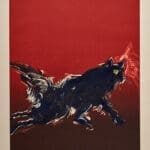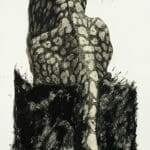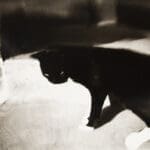Museums hold in their collections vast numbers of artworks and objects that rarely go on display. On average, museums only exhibit about five percent of their collection at any given time, and Plains Art Museum typically exhibits even less than five percent of the artwork it holds. The Collection Cross Section series of exhibitions examines simple, well-represented themes within the collection and presents these artworks in a straightforward manner with the goal of increasing the exposure of the collection itself.
A quick review of the collection revealed that cats are very well represented in artwork at Plains Art Museum. Why is this? There is no specific reason, but art regularly reflects our everyday lives and experiences, and cats have maintained a steady presence in human lives for thousands of years. Throughout human history cats have been viewed as deities and demons, companions and predators, muses and symbols of power. In more recent history images of cats have helped launch memes and fill social media accounts.
Artists through history have used images of cats as both subjects and symbols, with their meanings changing over cultures and time. During the Renaissance, cats in art were seen as suspicious, and could represent betrayal, deceit, or even the devil. This changed when cats became further domesticated in the 17th and 18th centuries and were later depicted in art as companions. Research has revealed that cats may have domesticated themselves, realizing that coexisting with humans would be beneficial. This was likely the beginning of an important bond between humans and felines that artists still strive to represent. This fascination can be seen in the cat images here at Plains Art Museum. From massive tigers to whimsical kittens, the diverse imagery shows that cats play many roles for humans today. Today, cats in art remain symbols of power and prestige, mischief and curiosity, or they can play the part of a voyeur, either within the artwork, or into the lives of the viewers themselves.




